stop start CITROEN DS4 2023 Service Manual
[x] Cancel search | Manufacturer: CITROEN, Model Year: 2023, Model line: DS4, Model: CITROEN DS4 2023Pages: 296, PDF Size: 9.91 MB
Page 212 of 296
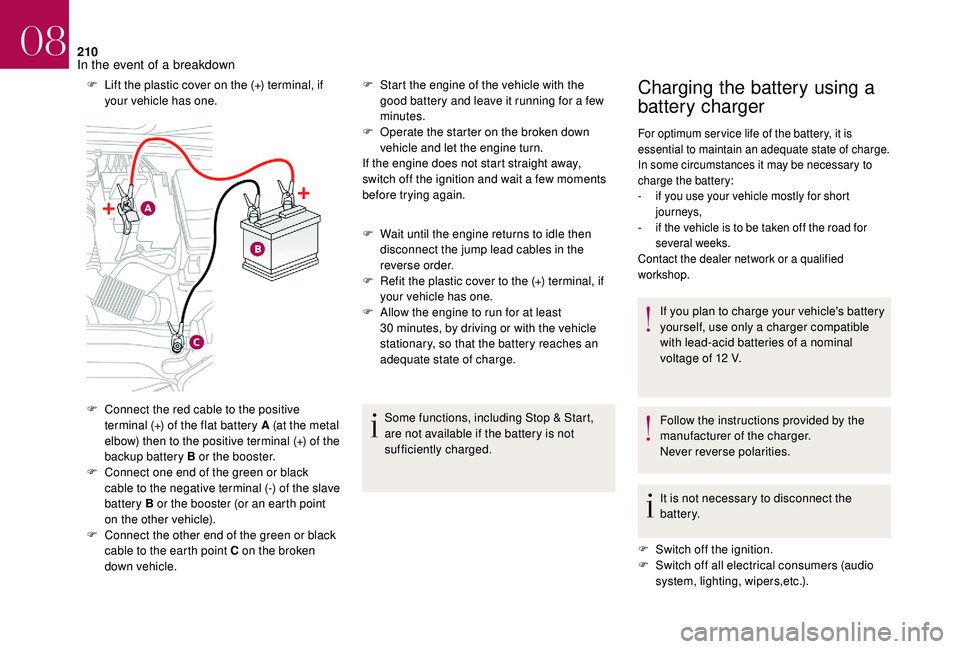
210
F Lift the plastic cover on the (+) terminal, if your vehicle has one.
F
C
onnect the red cable to the positive
terminal (+) of the flat battery A (at the metal
elbow) then to the positive terminal (+) of the
backup battery B or the booster.
F
C
onnect one end of the green or black
cable to the negative terminal (-) of the slave
battery B or the booster (or an earth point
on the other vehicle).
F
C
onnect the other end of the green or black
cable to the earth point C on the broken
down vehicle. F
S tart the engine of the vehicle with the
good battery and leave it running for a few
minutes.
F
O
perate the starter on the broken down
vehicle and let the engine turn.
If the engine does not start straight away,
switch off the ignition and wait a few moments
before trying again.
F
W
ait until the engine returns to idle then
disconnect the jump lead cables in the
reverse order.
F
R
efit the plastic cover to the (+) terminal, if
your vehicle has one.
F
A
llow the engine to run for at least
30
minutes, by driving or with the vehicle
stationary, so that the battery reaches an
adequate state of charge.
Some functions, including Stop & Start,
are not available if the battery is not
sufficiently charged.Charging the battery using a
battery charger
For optimum ser vice life of the battery, it is
essential to maintain an adequate state of charge.
In some circumstances it may be necessary to
charge the battery:
-
i
f you use your vehicle mostly for short
journeys,
-
i
f the vehicle is to be taken off the road for
several weeks.
Contact the dealer network or a qualified
workshop.
If you plan to charge your vehicle's battery
yourself, use only a charger compatible
with lead-acid batteries of a nominal
voltage of 12 V.
Follow the instructions provided by the
manufacturer of the charger.
Never reverse polarities.
It is not necessary to disconnect the
battery.
F
S
witch off the ignition.
F
S
witch off all electrical consumers (audio
system, lighting, wipers,etc.).
08
In the event of a breakdown
Page 213 of 296
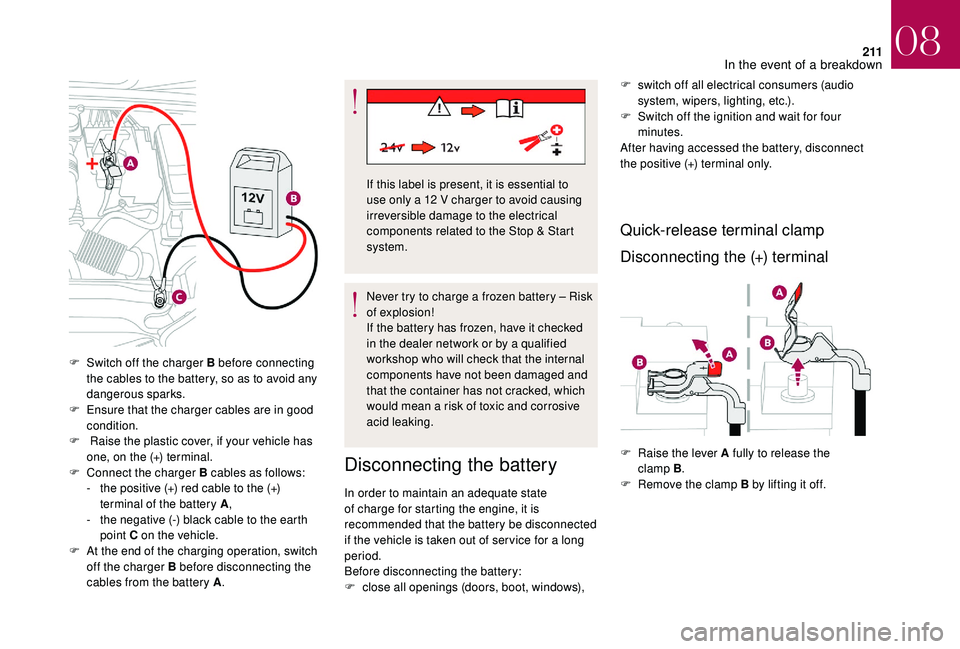
2 11
F Switch off the charger B before connecting the cables to the battery, so as to avoid any
dangerous sparks.
F
E
nsure that the charger cables are in good
condition.
F
R
aise the plastic cover, if your vehicle has
one, on the (+) terminal.
F
C
onnect the charger B cables as follows:
-
t
he positive (+) red cable to the (+)
terminal of the battery A ,
-
t
he negative (-) black cable to the earth
point C on the vehicle.
F
A
t the end of the charging operation, switch
off the charger B before disconnecting the
cables from the battery A . Never try to charge a frozen battery – Risk
of explosion!
If the battery has frozen, have it checked
in the dealer network or by a qualified
workshop who will check that the internal
components have not been damaged and
that the container has not cracked, which
would mean a risk of toxic and corrosive
acid leaking.
Disconnecting the battery
F switch off all electrical consumers (audio
system, wipers, lighting, etc.).
F
S
witch off the ignition and wait for four
minutes.
After having accessed the battery, disconnect
the positive (+) terminal only.
Quick-release terminal clamp
Disconnecting the (+) terminal
If this label is present, it is essential to
use only a 12 V charger to avoid causing
irreversible damage to the electrical
components related to the Stop & Start
system.
In order to maintain an adequate state
of charge for starting the engine, it is
recommended that the battery be disconnected
if the vehicle is taken out of ser vice for a long
period.
Before disconnecting the battery:
F
c
lose all openings (doors, boot, windows), F
Ra
ise the lever A fully to release the
clamp B .
F
R
emove the clamp B by lifting it off.
08
In the event of a breakdown
Page 214 of 296

212
Reconnecting the (+) terminal
Do not force the lever as locking will be
impossible if the clamp is not positioned
correctly; start the procedure again.
Following reconnection
If minor problems nevertheless persist
following this operation, contact the dealer
network or a qualified workshop.
By referring to the corresponding section, you
must reset certain systems yourself, such as:
-
o
ne-touch electric windows,
-
t
he date and time,
-
a
udio and navigation system settings.
Versions equipped with Stop & Start are
fitted with a 12 V lead-acid battery of
specific technology and specification.
Its replacement should be carried out
only in the dealer network or a qualified
workshop.
The Stop & Start system may not be
operational during the trip following the
first engine start.
In this case, the system will only be
available again after a continuous
period of immobilisation of the vehicle,
a period which depends on the exterior
temperature and the state of charge of the
battery (up to about 8 hours).
F
Ra
ise the lever A fully.
F
R
efit the open clamp B on the (+) terminal.
F
P
ush the clamp B fully down.
F
L
ower the lever A to lock the clamp B .
After reconnecting the battery, turn on the
ignition and wait 1 minute before starting
the engine, in order to enable the electronic
systems to initialise.Towing the vehicle
Procedure for having your vehicle towed or
for towing another vehicle using a removable
towing eye.
Access to the tools
The towing eye is installed in the boot under
t h e f l o o r.
To access it:
F
o
pen the boot,
F
r
aise the floor,
F
s
ecure it by hooking its cord on the hook on
the rear shelf support,
F
r
emove the towing eye from the holder.
08
In the event of a breakdown
Page 219 of 296

217
Petrol engines and towed loads
EngineV Ti 120PureTech 130 S&S THP 15 0
Gearboxes Manual 5-speed
(BVM5) Manual 6-speed
(BVM6) Automatic 6-speed
(BVA6)
Model codes:
NX... 5FS0
5FS0/1 HNYM/S
HNYM/1S
HNYM/2S 5FEA
Capacity (cm
3) 1,59 81,1 9 91,59 8
Max. power: EU standard (kW) 889611 0
Fuel UnleadedUnleadedUnleaded
Braked trailer (within the GTW limit)
on a 12% gradient (Kg) 1, 20 0
1, 20 0 800
Unbraked trailer (kg) 640675715
Recommended nose weight (kg) 757575
.../S: model fitted with Stop & Start.
.../1: model fitted with low rolling resistance tyres.
.../2: model fitted with very low rolling resistance tyres.
09
Technical data
Page 220 of 296

218
EngineTHP 160THP 165 S&S THP 210 S&S
Gearboxes Automatic 6-speed
(BVA6) Automatic 6-speed
( E AT 6 ) Manual 6-speed
(BVM6)
Model codes:
NX... 5FMA5GZT/S
5GZ T/1S 5GMM/S
Capacity (cm
3) 1,59 81,59 81,59 8
Max. power: EU standard (kW) 12012115 5
Fuel UnleadedUnleadedUnleaded
Braked trailer (within the GTW limit)
on a 12% gradient (Kg) 800
1,4 0 0 1,000
Unbraked trailer (kg) 715690 655
Recommended nose weight (kg) 757575
.../S: model fitted with Stop & Start.
.../1: model fitted with low rolling resistance tyres.
09
Technical data
Page 221 of 296

219
Diesel engines and towed loads
EngineBlueHDi 100e-HDi 115 BlueHDi 115 S&S
Gearboxes Manual 5-speed
(BVM5) Manual 6-speed
(BVM6) Manual 6-speed
(BVM6) Automatic 6-speed
( E AT 6 )
Model codes:
NX... BHY9HD8/S
9HD8/1S BHXM/S
BHXM/1S - /2S - /3S BHX T/1S
BHX T/2S
Capacity (cm
3) 1,5 6 01,5 6 0 1,5 6 0
Max. power: EU standard (kW) 7384 85
Fuel DieselDiesel Diesel
Braked trailer (within the GTW limit)
on a 12% gradient (Kg) 1, 25 0
1,3 0 0 1,3 0 01, 20 0
Unbraked trailer 630680 680640
Recommended nose weight 75757575
.../S: model fitted with Stop & Start.
.../1: model fitted with low rolling resistance tyres.
.../2: model fitted with very low rolling resistance tyres.
09
Technical data
Page 222 of 296

220
EngineBlueHDi 120 S&SBlueHDi 150 S&S BlueHDi 180 S&S
Gearboxes Manual 6-speed
(BVM6) Automatic 6-speed
( E AT 6 ) Manual 6-speed
(BVM6) Automatic 6-speed
( E AT 6 )
Model codes:
NX... BHZM/S
BHZM/1S - /2S - /3S BHZT/SAHRM/S
AHRM/1S
AHRM/2S AHW T/S
AHW T/1S
AHW T/2S
Capacity (cm
3) 1,5 6 01,9 971,9 97
Max. power: EU standard (kW) 8811 0132
Fuel DieselDieselDiesel
Braked trailer (within the GTW limit)
on a 12% gradient (Kg) 1,3 0 0
1, 20 0 1,3 0 01,3 0 0
Unbraked trailer 680640 74 074 5
Recommended nose weight 75757575
.../S: model fitted with Stop & Start.
.../1: model fitted with low rolling resistance tyres.
.../2: model fitted with very low rolling resistance tyres.
09
Technical data
Page 231 of 296
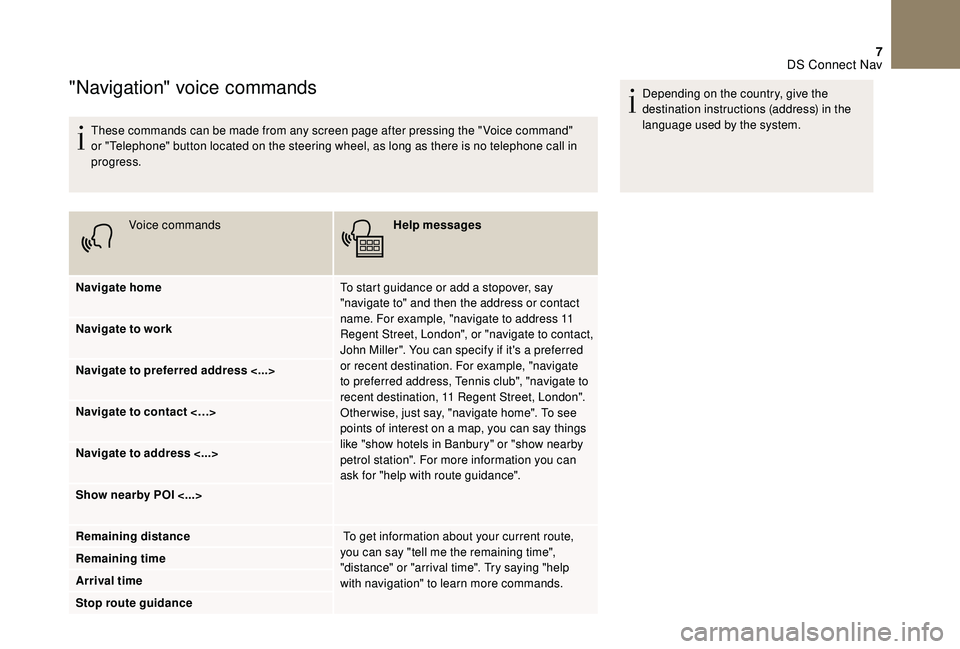
7
"Navigation" voice commands
These commands can be made from any screen page after pressing the " Voice command"
or "Telephone" button located on the steering wheel, as long as there is no telephone call in
progress.Voice commands Help messages
Navigate home To start guidance or add a stopover, say
"navigate to" and then the address or contact
name. For example, "navigate to address 11
Regent Street, London", or "navigate to contact,
John Miller". You can specify if it's a preferred
or recent destination. For example, "navigate
to preferred address, Tennis club", "navigate to
recent destination, 11 Regent Street, London".
Other wise, just say, "navigate home". To see
points of interest on a map, you can say things
like "show hotels in Banbury" or "show nearby
petrol station". For more information you can
ask for "help with route guidance".
Navigate to work
Navigate to preferred address <...>
Navigate to contact <…>
Navigate to address <...>
Show nearby POI <...>
Remaining distance
To get information about your current route,
you can say "tell me the remaining time",
"distance" or "arrival time". Try saying "help
with navigation" to learn more commands.
Remaining time
Arrival time
Stop route guidance Depending on the country, give the
destination instructions (address) in the
language used by the system.
DS Connect Nav
Page 266 of 296
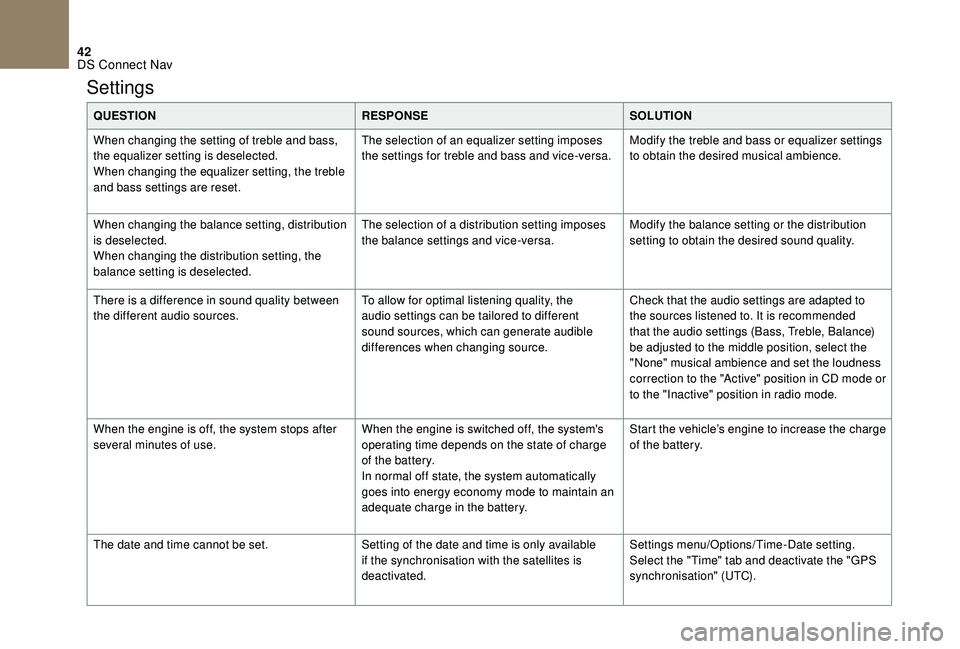
42
Settings
QUESTIONRESPONSESOLUTION
When changing the setting of treble and bass,
the equalizer setting is deselected.
When changing the equalizer setting, the treble
and bass settings are reset. The selection of an equalizer setting imposes
the settings for treble and bass and vice-versa.
Modify the treble and bass or equalizer settings
to obtain the desired musical ambience.
When changing the balance setting, distribution
is deselected.
When changing the distribution setting, the
balance setting is deselected. The selection of a distribution setting imposes
the balance settings and vice-versa.
Modify the balance setting or the distribution
setting to obtain the desired sound quality.
There is a difference in sound quality between
the different audio sources. To allow for optimal listening quality, the
audio settings can be tailored to different
sound sources, which can generate audible
differences when changing source.Check that the audio settings are adapted to
the sources listened to. It is recommended
that the audio settings (Bass, Treble, Balance)
be adjusted to the middle position, select the
"None" musical ambience and set the loudness
correction to the "Active" position in CD mode or
to the "Inactive" position in radio mode.
When the engine is off, the system stops after
several minutes of use. When the engine is switched off, the system's
operating time depends on the state of charge
of the battery.
In normal off state, the system automatically
goes into energy economy mode to maintain an
adequate charge in the battery.Start the vehicle’s engine to increase the charge
of the battery.
The date and time cannot be set. Setting of the date and time is only available
if the synchronisation with the satellites is
deactivated.Settings menu/Options/Time-Date setting.
Select the "Time" tab and deactivate the "GPS
synchronisation" (UTC).
DS Connect Nav
Page 288 of 296
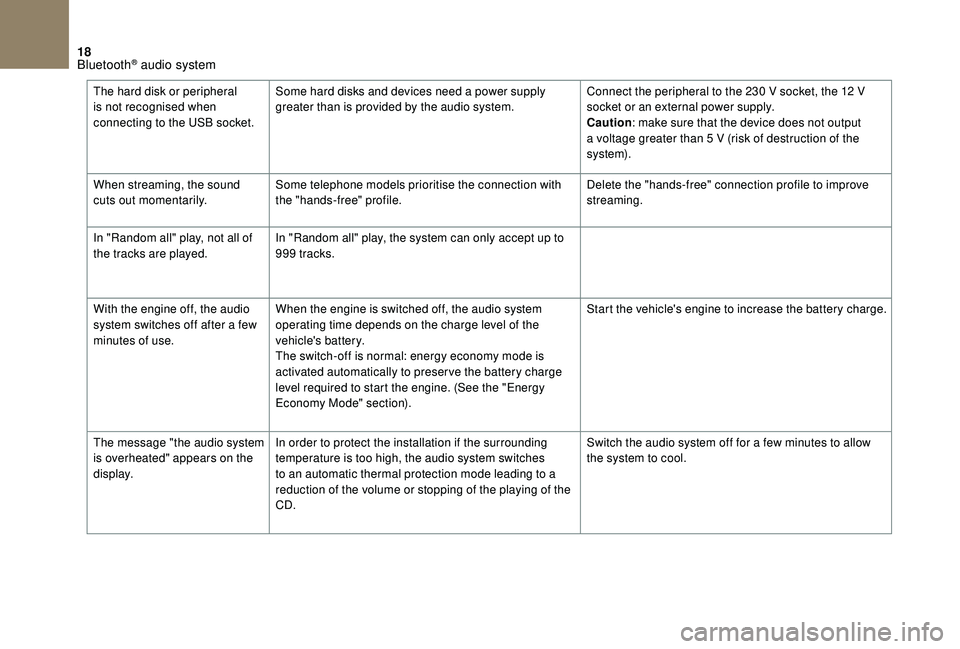
18
The hard disk or peripheral
is not recognised when
connecting to the USB socket.Some hard disks and devices need a power supply
greater than is provided by the audio system.
Connect the peripheral to the 230 V socket, the 12
V
socket or an external power supply.
Caution : make sure that the device does not output
a voltage greater than 5 V (risk of destruction of the
syste m).
When streaming, the sound
cuts out momentarily. Some telephone models prioritise the connection with
the "hands-free" profile. Delete the "hands-free" connection profile to improve
streaming.
In "Random all" play, not all of
the tracks are played. In "Random all" play, the system can only accept up to
999 tracks.
With the engine off, the audio
system switches off after a few
minutes of use. When the engine is switched off, the audio system
operating time depends on the charge level of the
vehicle's battery.
The switch-off is normal: energy economy mode is
activated automatically to preser ve the battery charge
level required to start the engine. (See the "Energy
Economy Mode" section). Start the vehicle's engine to increase the battery charge.
The message "the audio system
is overheated" appears on the
display. In order to protect the installation if the surrounding
temperature is too high, the audio system switches
to an automatic thermal protection mode leading to a
reduction of the volume or stopping of the playing of the
CD. Switch the audio system off for a few minutes to allow
the system to cool.
Bluetooth® audio system